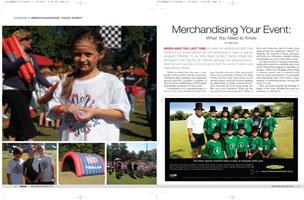
When was the last time you were out walking and didn’t see someone in a screen-printed tee shirt promoting an event or special occasion? Whether it’s an “Arts, Beats, & Eats” Festival (Royal Oak, Michigan) or the “Big Pig Jig” (Vienna, Georgia), the ubiquitous decorated tee shirt has been an iconic part of both the world of fashion and international events. While tee shirts have become a commodity and an anchor for any event merchandising plan, planners and organizers should carefully consider a number of factors before establishing a full-fledged merchandise program for their event.
 Consideration of a merchandising effort for your event should first and foremost include a review of the event itself. Does your event have a history? In other words, has the event been going on for enough years to provide decision-makers an opportunity to gauge critical factors? How long has the event been going on? Who are your attendees? What are the age and income demographics? What is the event’s objective and of course, how many people are expected to attend? Ultimately, the answers to these questions will help you formulate whether selling merchandise at your event makes sense.
Consideration of a merchandising effort for your event should first and foremost include a review of the event itself. Does your event have a history? In other words, has the event been going on for enough years to provide decision-makers an opportunity to gauge critical factors? How long has the event been going on? Who are your attendees? What are the age and income demographics? What is the event’s objective and of course, how many people are expected to attend? Ultimately, the answers to these questions will help you formulate whether selling merchandise at your event makes sense.
An ideal event for creating a merchandising plan would be a multiple-day event with a broad-based appeal to attendees of all ages. There’s an old adage about being a 'numbers game' and it certainly holds true for event merchandise. A successful merchandising plan first needs a large number of interested people viewing the items for sale.
Next, you must consider the message or theme of the event. Whether the event is a fundraiser, a celebration, a meeting or just a party, an important element is the message being conveyed by the event planners. The “National Transplant Games” or the “Special Olympics” will have a different weight from that of a local 5K race, or an ethnic festival. The sale of merchandise relies on the strength of the message much more than the 'souvenir' factor. Ask yourself whether you would be likely to wear that promotional tee shirt a few months after your event is over.
 So, after your careful analysis, you’ve decided to move forward with a merchandising plan. The next step is to decide how the merchandise is going to be marketed and sold. Does your event involve either the pre-sale of tickets, or a pre-registration process? In either of these two scenarios, there is an excellent opportunity to promote the sale of merchandise by communicating to ticket buyers or registrants by either providing a product flyer or coupon announcing the availability of the items available.
So, after your careful analysis, you’ve decided to move forward with a merchandising plan. The next step is to decide how the merchandise is going to be marketed and sold. Does your event involve either the pre-sale of tickets, or a pre-registration process? In either of these two scenarios, there is an excellent opportunity to promote the sale of merchandise by communicating to ticket buyers or registrants by either providing a product flyer or coupon announcing the availability of the items available.
Next, look at the number and placement of merchandise sale areas. Location of sale booths is critical to success. It’s a simple formula. Your goal is the have every single attendee pass by a merchandising area at least twice. Spend considerable time reviewing potential sites and get many opinions. The time you spend on this process will be well worth it.
Logistics now come into play. Your site, or sites will likely need power, lighting and storage. Merchandise can be stored in trailers or vans, but make sure they’re accessible. Cash registers, cash boxes and credit card processing are important aspects to consider. The larger the expected sales, the more important this consideration becomes. If your event is outdoors, all of the logistical considerations are magnified. Selling merchandise in the rain is not the way you want to spend your weekend.
 Protecting your assets, whether its merchandise, or cash is important. Consider your human assets. At this point, you should be developing your staffing model. Lay out a rough schedule of time and how many people you’ll need to support your merchandising effort. If you plan to use volunteers, and most event planners do, build your staffing model accordingly. Generally speaking, do not ask your volunteers to work more than a four-hour shift. Plan on extra staffing to cover busy time and make sure your site leader or supervisors are experienced, responsible members of your organizing team. If you are successful, there will be a large amount of cash on hand, and you will want to have a plan for safe storage and transporting of the proceeds.
Protecting your assets, whether its merchandise, or cash is important. Consider your human assets. At this point, you should be developing your staffing model. Lay out a rough schedule of time and how many people you’ll need to support your merchandising effort. If you plan to use volunteers, and most event planners do, build your staffing model accordingly. Generally speaking, do not ask your volunteers to work more than a four-hour shift. Plan on extra staffing to cover busy time and make sure your site leader or supervisors are experienced, responsible members of your organizing team. If you are successful, there will be a large amount of cash on hand, and you will want to have a plan for safe storage and transporting of the proceeds.
Lastly, now that you have identified that a merchandising plan is appropriate, and have calculated space and staffing needs, you must now make decisions regarding the items you want to sell. In the beginning I would strongly recommend that you work with a professional from the promotional products industry. There is a vast array of premium items available and with the proper lead time a professional can not only help you select items that are popular and appropriate for your event, but they can help source those items at the correct price point.
As mentioned earlier, most merchandise programs will include one or more styles of tee shirts. Tee shirts are a proven winner but there are a few simple rules to follow. The most important consideration is the design of the art that is going to be reproduced on the shirt. If this is your first time executing a merchandising program, I would work through a local graphic artist to help create a design that will be eye-catching and message driven. Remember that the cost of screen-printing in most cases is contingent on the number of colors in the design (you will pay a screen charge and run charge for each color). Keeping the design to one or two colors will help keep costs in line. 
Depending on the event, it might be beneficial to work through a local screen-printer who is willing to set up a screen- printing operation on site at your event. You will pay more to the vendor for this service, but you won’t end up with a lot of unsold inventory at the end of your event. Spend careful planning time with tees because beyond the profit potential offered in the sale of shirts, every shirt sold becomes a walking billboard for your event, this year and in the future. Additional wearables should be kept to a minimum because you will always be dealing with sizing and fit considerations.
 The balance of your merchandise program should include a traditional mix of items appropriate for the type of event you are running. Avoid breakables like coffee mugs, and glassware. Also avoid items that people would have trouble carrying during their attendance at the event. Consider selling a plastic souvenir drink container. It is often demonstrated that people will pay more for souvenir drinkware and if you’re getting a percentage of the food and beverage concessions you’ll increase your take there as well. Again, a promotional products professional can help guide you through your purchase decisions.
The balance of your merchandise program should include a traditional mix of items appropriate for the type of event you are running. Avoid breakables like coffee mugs, and glassware. Also avoid items that people would have trouble carrying during their attendance at the event. Consider selling a plastic souvenir drink container. It is often demonstrated that people will pay more for souvenir drinkware and if you’re getting a percentage of the food and beverage concessions you’ll increase your take there as well. Again, a promotional products professional can help guide you through your purchase decisions.
Your decisions will often be a blend of style, cost, and event-appropriate merchandise. Remember that your selling window is very short. Pricing models should be simple. Try to keep your prices at standard increments, ie. $10 for a tee shirt rather than $9.95. Build your sales tax into the total price so that the $10 shirt is the transaction. Making change will be much simpler and will keep your operation working smoothly. Merchandise left over is often not saleable and will be an overall negative to your program. Plan your final day fire-sale accordingly and minimize your potential leftover merchandise.
After analyzing your event to make sure a merchandise program makes sense, incorporate a strategic plan when looking at your selling locations. Cover all the critical details from staffing to security, and utilize a professional when it comes to item selection. Be conservative in first year expectations. Keep your inventory purchases moderate and have a good back up plan should event parameters change. With a bit of luck and a lot of planning, your event merchandising plan will be a great success.

